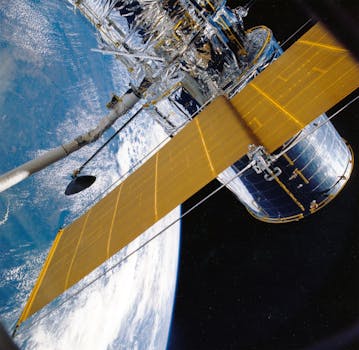GEO Satellites: Understanding the Importance of Geostationary Orbit

GEO satellites, or Geostationary satellites, are a type of satellite that orbits the Earth at an altitude of approximately 36,000 kilometers, remaining stationary relative to a fixed point on the planet. The Focus Keyword: GEO satellites have been a cornerstone of satellite communications for decades, providing a wide range of applications and services to users around the world. From television broadcasting to telecommunications, navigation, and weather forecasting, GEO satellites have revolutionized the way we communicate and access information.
The concept of geostationary orbit was first proposed by science fiction writer Arthur C. Clarke in 1945. However, it wasn’t until the launch of the first geostationary satellite, Syncom 2, in 1963 that the technology began to take shape. Since then, hundreds of GEO satellites have been launched, with many more planned for the future. One of the primary benefits of GEO satellites is their ability to provide continuous coverage of a specific region or country. By remaining stationary relative to a fixed point on the Earth, GEO satellites can maintain a constant signal, allowing for uninterrupted communication and data transmission.
GEO satellites have a wide range of applications, including television broadcasting, telecommunications, navigation, and weather forecasting. They are also used for earth observation, disaster recovery, and scientific research. In addition, GEO satellites play a critical role in global navigation satellite systems, such as GPS, GLONASS, and Galileo. The importance of GEO satellites cannot be overstated, as they have enabled the development of modern telecommunications and have had a significant impact on the global economy.
In recent years, there has been a growing trend towards the development of high-throughput satellites (HTS), which offer faster data speeds and greater capacity than traditional GEO satellites. HTS have enabled the widespread adoption of broadband internet and video streaming services, and have revolutionized the way we access and consume information. Furthermore, the use of GEO satellites in 5G networks is becoming increasingly important, as they provide a means of extending coverage to remote and underserved areas.
The Benefits of GEO Satellites
GEO satellites offer a number of benefits, including global coverage, high availability, and low latency. They are also relatively low cost compared to other types of satellites, making them an attractive option for many applications. Additionally, GEO satellites are easy to maintain and upgrade, as they can be accessed and serviced by a single satellite operator.
The Challenges of GEO Satellites
Despite their many benefits, GEO satellites also face a number of challenges. One of the primary challenges is congestion in the geostationary orbit, which can lead to interference and signal degradation. Additionally, GEO satellites are vulnerable to space debris and cyber attacks, which can have significant consequences for satellite operations and user safety. Furthermore, the regulatory environment for GEO satellites is complex and often fragmented, making it difficult for satellite operators to navigate and comply with relevant laws and regulations.
The Future of GEO Satellites
As the demand for satellite communications continues to grow, the future of GEO satellites looks bright. Advances in technology and innovation are enabling the development of more efficient and cost-effective satellites, which will help to drive growth and adoption in the industry. Additionally, the use of artificial intelligence and machine learning is becoming increasingly important in satellite operations, enabling more autonomous and intelligent satellites. As the satellite industry continues to evolve, it is likely that GEO satellites will play an increasingly important role in shaping the future of telecommunications and beyond.
In conclusion, GEO satellites are a vital component of modern telecommunications, offering a wide range of applications and services to users around the world. From television broadcasting to telecommunications, navigation, and weather forecasting, GEO satellites have revolutionized the way we communicate and access information. As the demand for satellite communications continues to grow, it is likely that GEO satellites will remain an essential part of the telecommunications landscape for years to come.




